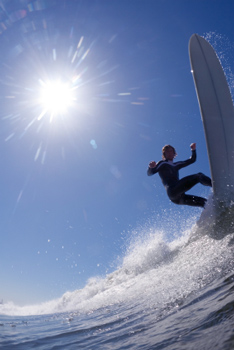How to Prevent Surfer's Eye
 How does a wing-like membrane growing over your eyeball sound? If you answered “not so sweet,” then read on. There’s no time like the present to begin taking steps to prevent conjunctival pterygium — or “surfer’s eye.” This surfing guide will provide you with some valuable information regarding this degenerative eye condition.
How does a wing-like membrane growing over your eyeball sound? If you answered “not so sweet,” then read on. There’s no time like the present to begin taking steps to prevent conjunctival pterygium — or “surfer’s eye.” This surfing guide will provide you with some valuable information regarding this degenerative eye condition.
What is Surfer’s Eye?
Repeated exposure to excessive ultraviolet (UV) radiation, glare, wind, dust, seawater, and sand can cause damage to the conjuctiva (a clear mucous membrane on the eyeball’s surface). Over time, these irritants can result in degeneration of the collagen fibers that make up this conjuctival membrane. To make matters worse, yellowish and thicker fibers grow in its place — not exactly attractive. This new membrane (called a “pterygium”) grows from the bottom, nasal corner of the eye in a triangular or winged shape with the long corner pointing toward the cornea. If allowed to progress, the pterygium can warp the surface of the cornea and even block light from entering the eye.
Why Surfers?
All water and snow sports enthusiasts can potentially be exposed to many of the same irritants that cause surfer’s eye. The condition is also seen in non-surfers. Unlike surfers, however, the majority of skiers, snowboarders, boaters, fisherman, kayakers, etc, wear eye protection — in the form of goggles or sunglasses. Plus, surfing involves repeated underwater head submersions and blasts to the face from seawater. As a result, surfers are at the greatest risk of conjunctival pterygium — hence the nickname.
Symptoms of Surfer’s Eye
Here are a few signs that you may be developing surfer’s eye:
- Dry and itchy eye
- Burning sensation of the eye
- Persistent redness of the eye
- The feeling of a foreign object in the eye
- Eye inflammation
- Bloody tears
- Blurred or otherwise impaired vision
Prevention of Surfer’s Eye
The good news is that surfer’s eye is preventable. Here are five tactics that can help you avoid conjunctival pterygium:
1. Wear High-Quality Sunglasses
Make a habit of wearing sunglasses whenever you’re outside or driving during the day. Most importantly, avoid glasses that are on sale at the local gas station. It’s best to go with shades that provide 100 percent ultra violet (UV) protection. Polarized lenses are also key to reducing glare when you’re around water or snow. For the best defense, wear wrap-around models that shield the eyes from irritants on the side, and a hat to guard against UV rays sneaking in from above.
2. Use Eye Protection When You Surf
It’s been estimated that 80 percent of exposure to UV rays during an average person’s lifetime occurs before the age of 18. Since children have larger pupils than adults, wearing premium sunglasses from a young age can significantly reduce the risk of developing degenerative eye conditions.
Eyewear for water sports has come a long way in recent years. You can find great shades for surfing that are very functional and look more like sunglasses than a diving mask — although watertight models do offer more protection. In addition, new strap designs help keep these shades on your face in the majority of conditions, and allow them to float in the event that a wave rips them off of your face.
3. Wash your Face with Warm Water
Washing your face and eyes with warm water as soon as possible after a surf session is very important. This not only will remove a lot of potential irritants from the eye socket, it will also keep both the eyelid and, in turn, the surface of the eye healthy.
4. Maintain Healthy Air Indoors
Let fresh air into your home or office whenever possible and don’t allow the air to get too dry. If you’re heating or cooling inside air, containers of uncovered water or humidifiers can help increase inside humidity levels considerably.
5. Apply Moisturizing Eye Mist
The more often you surf and are out in the elements, the greater the need for maintaining optimal eye-moisture levels. Unlike eye drops, moisturizing mists can be used as frequently as needed.
Treatment
 In some cases, lubricating eye drops can slow down or even stop the advance of conjunctival pterygium and alleviate discomfort. However, surgery is the only way to remove the growths completely.
In some cases, lubricating eye drops can slow down or even stop the advance of conjunctival pterygium and alleviate discomfort. However, surgery is the only way to remove the growths completely.
The most common surgical technique used today involves the removal of the pterygium and filling the resulting gap left in the mucous membrane of the eye with a tissue transplant from the upper eyelid. The graft is held in place either with tiny stitches that dissolve, or a modern tissue adhesive. Exercise is not recommended for at least two weeks after the procedure in order to reduce the risk of bleeding. Unfortunately, recurrence of the growths is still possible post-surgery, which makes prevention measures even more necessary.
Roll of the Dice
Most surfers tend to be minimalists — board shorts, board, and go! However, every sport has a price. In the case of surfer’s eye, you can either spend a little time and energy to prevent conjunctival growths, or run the risk of potentially paying a surgical price tag — not to mention the cost of lost water time. Ultimately, it’s your vision and your call.
